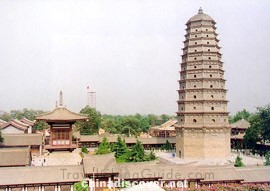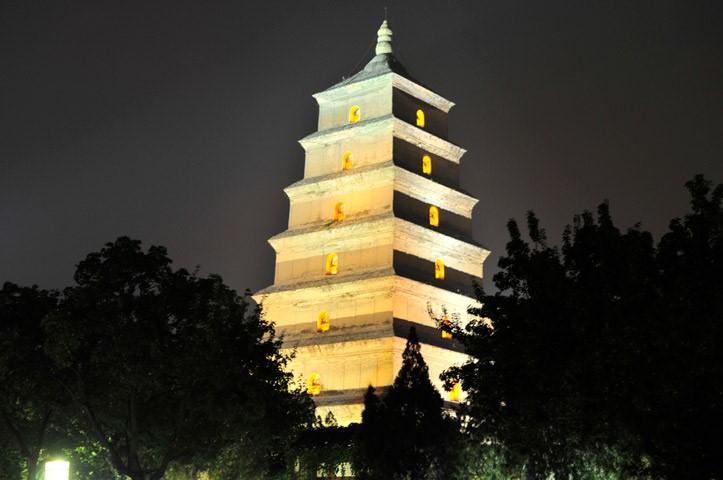Famen Temple

The Famen Temple is located in Famen Town 120 kilometers west of Xi'an. It is a famous temple in China. It was built in ancient times to house the bones of the fingers of Sakyamuni, the founder of Buddhism.
Famen means the initial approach to become a Buddhist believer. The Famen Temple was constructed in the Eastern Han Dynasty because of the stupa there. The Famen Temple stupa also known as "the Real Spirit Pagoda", is famous for the fact that it houses a finger bone of Sakyamuni, and the Famen Temple and its stupa enjoyed the reputation of being the "forefather of pagodas and temples in Central Shaanxi".
The Famen Temple was originally called Asoka Stupa. During the years of Zhenguan in the Tang Dynasty it was reconstructed into a wooden four-storey structure. After 1,502 years of existence, the wooden stupa, in1569, fell down due to an earthquake. In 1579, Buddhists in Fufeng County collected alms and donations to rebuild the stupa into an exquisite and splendid brick octagon of 13 storeys, 47 meters in height. It took 30 years to complete the whole project. Because of the massive weight of the stupa and relatively small underground palace, a problem developed due to the great weight above ground and the small foundation underground. Fifty-four years after its completion, the stupa began to tilt toward the southwest. In 1976, because of constant rain in Fufeng County and the impact of the Songpan earthquake that occurred in Sichuan , the tilt of the stupa increased toward the southwest. In 1981, the western side of this tilted stupa fell off after being subjected to constantly rainy season. Most of the body of the stupa collapsed shortly thereafter. Only part of the body remained on an incomplete platform of broken bricks.
In 1985, the Shaanxi Provincial Government decided to rebuild the stupa imitating the brick one from the Ming Dynasty. While clearing the stupa foundation, the underground palace was accidentally discovered. For more than 1,000 years, the palace had housed the remains of the finger bones of Sakyamuni and other valuable relics that enshrined these precious bones.
According to tablet inscriptions discovered in the underground palace, the finger bones (Buddhist relics) had always been kept inside the Famen Stupa.
The underground palace at Famen Temple is 21.2 meters long, and covers an area of 31.84 square meters. It is the largest palace in all the temples and stupas discovered so far in China. The four finger bones discovered there are most riveting. The first one was kept in an eight-layered chest in the back room. The finer bone, 40.3 millimeters long and hollow on both sides, hung vertically on a silver column on a gold stupa base. The second , which is like the first in shape, was kept in a double-eave marble coffin in the center room of the palace. The third one was kept in a five-layered marble chest, which was retained in a secret niche in the back room. This finger bone is tube-like, 37millimeters long and is white and yellow in color. The fourth one was kept in a color-painted King Asoka stupa in the front room. Its color and shape are very much like those of the first and second finger bones. Zhao Puchu, Chairman of the All-China Buddhism Association and Zhou Shaoliang, Vice-chairman of the Buddhism Association, determined that the third finger bone is a bier stone, which means it is the only real one of the Buddhism master. The other three were "shadow bones", imitations which the Tang emperor had made in order to protect the real one.
The Buddhist relics discovered at the Famen Temple are the only real finger bones that have been discovered and maintained in the world. There are many other relics that unearthed with the underground palace. They are considered to be national treasures.
The technique of gold brocade weaving developed in the Tang Dynasty was surprisingly exquisite. The gold thread used in weaving was only 0.1 millimeter thick, finer than a hair. Silk thread was taken as the core around which the gold thread turned one circle after another. 1 meter of thread could make 3,000 circles. The embroidered skirts that Empress Wu Zetian had consecrated were made out of this material.
The secret seladon is made of Chinese green porcelain. The techniques used are very complex and it is difficult to process. The court kept all of this information secret, which is indicated by its name, "secret seladon". Finding the secret seladon that was discovered at Famen Temple was a breakthrough for the study of the history of Chinese porcelain. It provides much information used for the determination of age and characteristics of this type of porcelain.
The four-faced, twelve-ringed gold and silver relics discovered at the Famen Temple are of high quality and great value. The gold gilded monk's cane is the most precious Buddhist staff found in terms of style, technology and material. Its discovery is unprecedented in all the archaeological findings of the Tang Dynasty, as well as the discovery at the Famen Temple, of so many treasures of different types, whose quality and preservation are incredible.
The Famen Temple stupa has been rebuilt based on the model from the Ming Dynasty. The underground palace remains intact, and a passage into it for visitors has been constructed. On the right side of Famen courtyard, a museum housing the treasures was built according to a model of the temple from the Tang Dynasty.





